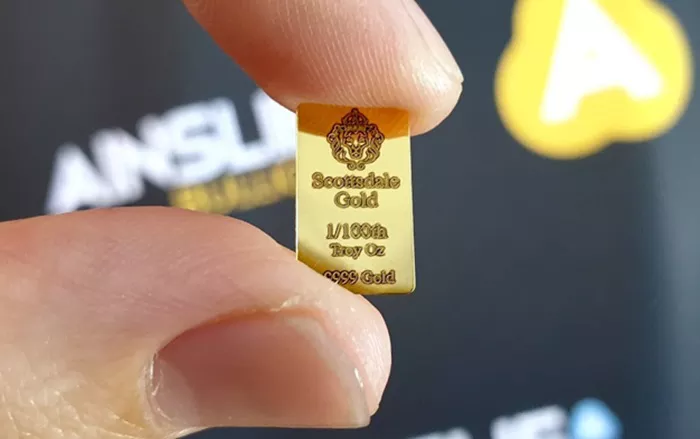Gold has been a symbol of wealth and a key investment asset for centuries. Its value is often quoted in troy ounces, with a troy ounce equal to approximately 31.1 grams. However, for precision, especially in smaller transactions or investments, understanding the value of smaller fractions, such as 1/100 of an ounce, is crucial. This guide delves deeply into how to calculate the value of 1/100 of an ounce, explores factors affecting gold prices, and examines practical considerations for investors and collectors.
Understanding Gold Measurement and Pricing
Troy Ounce vs. Avoirdupois Ounce
Gold prices are measured in troy ounces, which are different from the avoirdupois ounces used for most other goods. One troy ounce is equivalent to approximately 31.1 grams. In contrast, an avoirdupois ounce is about 28.35 grams. This distinction is important when dealing with precious metals.
Current Gold Price
Gold prices fluctuate based on market conditions. Prices are typically quoted per troy ounce in U.S. dollars (USD). To determine the value of 1/100 of an ounce, you need to know the current price of gold. This price can be found on financial news websites, commodity exchanges, or through financial market apps. For illustrative purposes, let’s use a hypothetical price of $1,900 per troy ounce.
Calculating the Value of 1/100 of an Ounce
Converting the Fraction to Decimal
1/100 of an ounce can be converted to decimal form:
- 1/100 =0.01 ounces
Calculation
To find the value of 0.01 ounces of gold, multiply the current price per ounce by 0.01:
- Value=Price per ounce×0.01
Using the assumed price of $1,900 per ounce:
- Value=1900×0.01=19 USD
Thus, 1/100 of an ounce of gold would be valued at $19.
See also: How Much Is 100 Oz of Gold Worth?
Factors Affecting Gold Prices
Market Demand and Supply
Gold prices are largely driven by the balance between supply and demand. Increased demand, especially during times of economic uncertainty, can lead to higher prices. Conversely, an oversupply or reduced demand can decrease prices.
Economic Conditions
Economic stability and growth impact gold prices. During economic downturns or periods of high inflation, gold is considered a safe haven, leading to increased prices. Conversely, economic growth and stability can lead to lower gold prices as investors shift to other assets.
Geopolitical Events
Global events such as political unrest, wars, or trade disputes can affect gold prices. In times of geopolitical uncertainty, investors flock to gold as a stable investment, which can drive up prices.
Interest Rates
Interest rates set by central banks influence gold prices. Higher interest rates can make gold less attractive compared to interest-bearing assets, potentially lowering gold prices. Conversely, lower interest rates can increase gold’s appeal, driving up prices.
Currency Strength
Gold is priced in U.S. dollars, so fluctuations in the value of the dollar impact gold prices. A stronger dollar can make gold more expensive for foreign investors, reducing demand and lowering prices. A weaker dollar can have the opposite effect, increasing gold prices.
Practical Considerations for Investors and Collectors
Gold Coins and Bars
Gold is often bought and sold in the form of coins and bars. Coins such as the American Gold Eagle or the Canadian Gold Maple Leaf may be issued in fractional weights, including 1/100 of an ounce. Knowing the value of these smaller fractions helps in assessing their worth and making informed decisions about buying or selling.
Gold Jewelry
Gold jewelry is usually sold based on its gold content. If a piece of jewelry contains 1/100 of an ounce of gold, understanding the current price of gold helps in evaluating its value. For example, a ring with 1/100 of an ounce of gold, assuming the price of gold is $1,900 per ounce, would have a gold value of $19.
Investment Portfolios
For investors holding gold in their portfolios, knowing the value of fractional gold amounts is essential for tracking performance. If your portfolio includes small amounts of gold, such as 1/100 of an ounce, it’s crucial to understand its current value for accurate portfolio assessment and decision-making.
Gold Trading
Active traders who buy and sell gold need to quickly calculate the value of fractional units. Efficiently determining the value of 1/100 of an ounce ensures precise pricing and effective transaction management.
See also: How Much Is 10.2 Grams of Gold Worth?
Additional Insights
Gold as a Hedge Against Inflation
Gold is often used as a hedge against inflation. During inflationary periods, the value of currency decreases, but gold tends to retain its value. Investors often turn to gold during these times to preserve wealth.
Gold Market Instruments
There are various financial instruments related to gold, including futures contracts, options, and gold-backed ETFs. Understanding the value of physical gold, such as 1/100 of an ounce, helps in comprehending the value of these financial instruments and their underlying assets.
Historical Gold Prices
Historical price trends can provide context for current gold prices. Studying past gold prices helps investors understand market cycles and make informed predictions about future price movements.
Conclusion
Calculating the value of 1/100 of an ounce of gold involves multiplying the current gold price per ounce by the fractional amount (0.01). With an assumed gold price of $1,900 per ounce, this fraction would be worth $19. However, since gold prices fluctuate, it’s important to use the most recent price for accurate calculations. Understanding the factors influencing gold prices—such as market demand, economic conditions, geopolitical events, interest rates, and currency strength—provides valuable context for interpreting gold’s value. Whether for investment purposes, gold trading, or evaluating gold jewelry, having a clear grasp of these calculations and factors ensures more informed financial decisions.
Related Topics:

